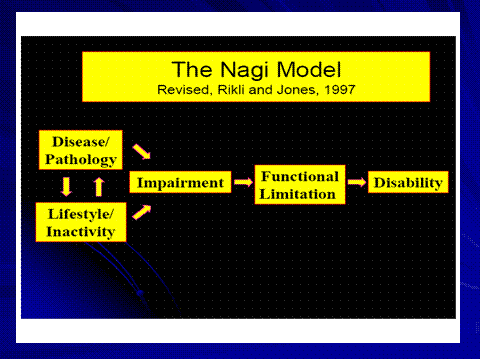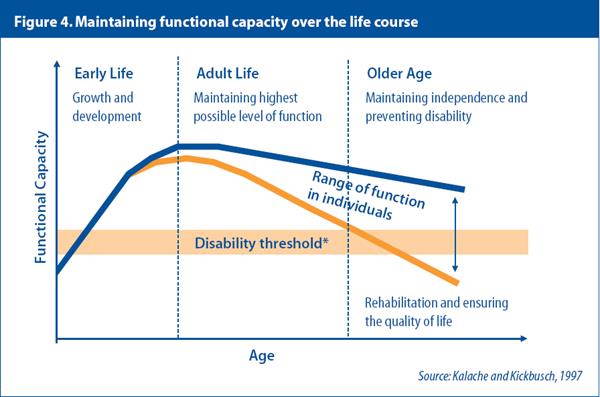Balance Training Exercises to Prevent Falls
by Dan Ritchie, PhD. (1/26/14)
 Balance and Mobility can become a quality of life issue as people age. The fear of falling can become life altering, and that fear can become a self fulfilling prophecy due to the subsequent lifestyle changes, as people become afraid to venture out they become less active. In this article the background on the severity of falling will be discussed. But then solutions to conquering the fear of falling and continuing to live with high levels of confidence, and functional independence will be described and depicted.
Balance and Mobility can become a quality of life issue as people age. The fear of falling can become life altering, and that fear can become a self fulfilling prophecy due to the subsequent lifestyle changes, as people become afraid to venture out they become less active. In this article the background on the severity of falling will be discussed. But then solutions to conquering the fear of falling and continuing to live with high levels of confidence, and functional independence will be described and depicted.
Background on Falls
Falling is a significant health issue for the elderly of the nation. Unintentional injuries are the fifth leading cause of death in older adults (after cardio-vascular, cancer, stroke, and pulmonary causes), with falls being the leading cause of injury-related deaths, surpassing auto accidents by nearly 50% (1). By comparison auto accidents are the number one cause of accidental death from age 1-64. In 2002, falls caused 12,800 unintentional injury deaths (2). In recent years prominent individuals such as David Brinkley, George Burns and Dr. Robert Atkins suffered fatal falls.
Fatalities due to falls represent only a small portion of the impact and cost of falls. In 2002, 1.6 million older adults 65+ were treated in hospital emergency departments, and 388,000 of those treated were admitted for their injuries (3). Current estimates of the annual direct and indirect costs associated with fall related injuries range from 75-100 billion dollars in the U.S. alone (4). In 2001, there were approximately 327,000 hospital admissions for hip fractures, with over 95% caused by a fall (5). It is estimated that this figure will surpass 500,000 by the year 2040 as a result of the rapidly increasing older adult population (6), with associated direct costs for hip fractures reaching $240 billion (7). While hip fracture is almost never listed in cause of death, 25% of individuals die within a year of the injury and another 25% never return home.
To put it another way a woman’s risk of hip fracture is greater than her risk of breast cancer, and the survival rates for breast cancer are better than for hip fracture. Prevention of 10%-20% of falls would represent a savings of billions of dollars annually in health care costs, not to mention significant disruptions in lifestyle changes from assisted living decisions and having to leave home for assisted care.
Another Consequence of Falling: Lower Quality of Life
Falling is also a significant quality of life issue. Once a serious fall occurs, quality of life begins a downward spiral. Due to an increased anxiety about falling and injury an individual may venture out of their home less often. Long term this leads to an increasingly less active lifestyle, further physical decline, and risk of losing the ability to live independently. Losses in function and mobility which, in turn, can lead to increased disability and falling, can be slowed and/or treated through early detection and targeted exercise programming (8-13).
So now that you are thoroughly educated if not scared lets talk about how we should prepare for the changes that come with age and incorporate some exercises that will help maintain and improve balance and coordination so you don’t become one of these statistics. There are two simple models that we like to use to show older adults that they really are on a progression or a trajectory through the aging process. Now there are some things we cannot modify or change on that aging course. For example we can’t change your gender, your age, genetic factors, vision problems, but we can impact your lifestyle and for this article we are talking about your choice to be active and include exercises that will maintain high levels of balance and function into your 90s.
Figure 1. The Nagi Model: Revised (19)

The Path to Disability (or The Path to Avoid)
The Nagi Disability Model (18) describes a four-stage progression to disability (pathology, impairment, functional limitations, disability). The takeaway from this revised model is that the individual may hold a significant choice influencing, impairment(s), functional limitations and ultimately disability. While each individual may not be able to control diseases, lifestyle is a personal choice and choosing inactivity may result in the consequence of impairment, leading to functional limitation leading to disability.

This chart depicts what we like to talk about as the trajectory that you are on as you age. We know that typically people peak around age 30. For some sports it is younger for others it is older, but if we begin to decline at age 35, then it really is important that we in the best shape possible at age 50, 60, 70 all along the course. You notice there are two trajectories pictured one that drops below the disability threshold and one that stays above it, which one would you choose? We fully believe that most older adults should follow the higher trajectory, and in many cases that choice is yours. So we encourage you to follow the sample exercise routine we have given you, and seek out more resources to aid you in maintaining the highest level of function possible.
One start would be to visit our website to watch some sample video or download additional exercise manuals, the author also welcomes your emails with questions. You should consult with your medical provider befor starting any exercise program, including this one.
Balance or Gait Walking Exercises
1. Marching
Marching with Arm raised overhead
Marching while carrying something (laundry basket, medicine ball, milk jug)
2. Goose-Step (or Straight Leg March)
Again you can add Arm movements or objects to carry
3. Tandem Stance, and Tandem Walk
This exercise is performed with one foot directly in front of the other, heel toe. You can perform standing stationary exercises with arm movements, or you can perform in a walking movement fashion.
4. One-Legged Stand
This exercise not pictured is as it sounds standing on one leg.
Level 1 Stand on one leg with assistance, wall or chair
Level 2 Stand on one leg no assistance
Level 3 Stand on one leg eyes closed with assistance
Level 4 Stand on one leg eyes closed no assistance
5. Sideways Walk or Lunge
Walk Sideways or take large Lunging steps sideways
6. Stepping over the Object Exercise
Practice stepping over curbs, cats, dogs, do in all four directions, forward, backward, right and left use a wall for assistance if necessary
Strength and Balance Exercises
1. Lunges
This movement is as it sounds a lunge length step, a step longer than a normal stride. Can add a weighted ball, or object, can add reaching, twisting for more difficulty
2. Step-Ups
Use a step around the home or purchase an exercise step. Step up focusing on one leg doing the work, can add a weight, or reach for more balance difficulty. The ability to climb stairs while carrying laundry or groceries or other household items is an essential task for independent living.
3. Crossover Reach (or Punch)
Take a large step, from that stance reach forward at approx shoulder height crossover and reaching as far forward as possible. Can visualize as if you are trying to throw a crossover punch, or reach for an object as far as possible. This exercise should challenge your balance to the point you feel the sensation of falling over from right to left.
Summary
The exercises shown and described certainly are not a complete exhaustive list. There are endless arrays of balance and mobility exercises. Certainly the incorporation of a general strength training program is essential for maintaining functional strength as well, but maintaining strength is not enough, training and retraining coordination and balance is essential to ensure long term high levels of function and independence.
About the Author
Dan Ritchie, has a broad background in the fitness industry including training and management in commercial and university/hospital-based fitness, for-profit, notfor-profit and educational facilities. His primary areas of expertise are in personal training for special populations: athletes, pregnancy, blind, stroke recovery, Parkinsons, multiple sclerosis, cerebral palsy, Fibromyalgia, Alzheimers, etc.
He has worked with Division I athletes some of whom have been professionally drafted. He has also worked on state funded research on exercise for severe dementia. He regularly presents at national and regional conferences and has been active on committees for the American College of Sports Medicine.
For more resources feel free to contact the author directly or visit his website.
(c) 2014 Prism Innovations, Inc. All Rights Reserved.